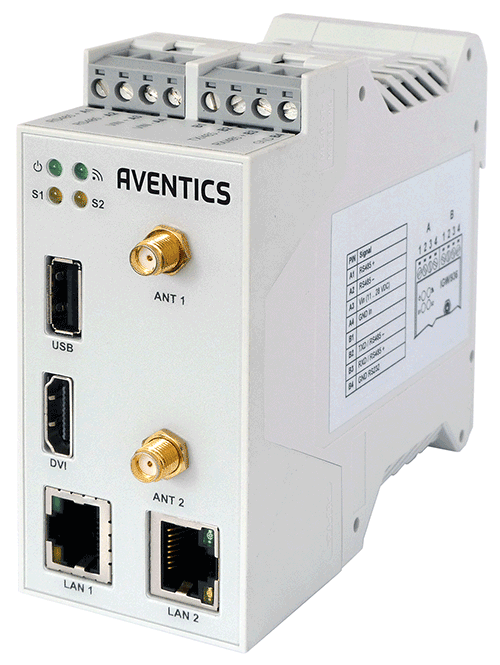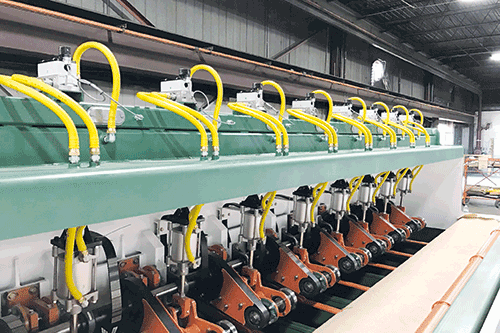
Manufacturing is currently undergoing a digital transformation powered by the Industrial Internet of Things (IIoT). One important aspect of this transformation is smart pneumatics. Integrating smart pneumatic devices into automation systems and equipment is a proven way to collect valuable data that improves productivity and efficiency. However, for some, taking the first steps toward digital transformation may seem challenging.
For end-users responsible for maintaining machines and keeping them running, the path is clear. An IIoT system provides data from the machine, ensuring its systems or components are working within their normal range. In that regard, the end-users are the ones pushing for IIoT implementation.
The disconnect is often with machine builders. They may have multiple customers pushing them for IIoT solutions, so OEMs are asking, “How do you implement that? Who has the product to do that? And what should we be monitoring?”
Pneumatics has taken advantage of diagnostic features for some time. For example, we can sense whether the power is too low or too high, or whether there is a short circuit in an I/O system which causes a failure. Now we move it a step further with sensors and the ability to use I/O systems to capture component performance data. The most common struggle causes people to ask such questions as “I have all this data, but what does it mean? How do we turn that data into useful information?”
Understanding how this struggle creates challenges − and opportunities
The focus has shifted to how end-users convert that data into useful information and react to, or even predict, failure. For example, the Emerson Aventics ST4-2P programmable sensor has been in our product line for years. It measures travel distance and velocity for pneumatic cylinders. We can sense the velocity of the piston in the cylinder, but we can also use the sensor data to monitor the performance of cushions and shock absorbers inside the cylinder. This ensures they perform within a certain specification window. If you interpolate that data, you can ensure the cylinder is performing as expected and quickly determine if it needs maintenance attention. You can see the data today in the PLC and with a gateway like the Emerson Aventics Smart Pneumatics Monitor, you can analyse the data to create useable information to figure out what is going on with the machine.

Let’s look at energy consumption, for example. You can measure the air pressure going into the system. You can measure the flow and correlate the result to an event and conclude that when you turn on a given valve, you get a certain flow. If the flow deviates when the valve is on next time, there must be something wrong with the system. The tube may have come out or the seals may be wearing on the cylinder. You may know something is off, but what you do with that information and how you use it is the differentiator. Machine builders seek to implement ways to leverage IIoT capabilities.
The responsibility to address problems uncovered by the data falls on both the OEM and the component manufacturer. Our IIoT approach is not ‘IIoT in a Box’. We understand that success requires collaboration and support as well. OEMs and end users would typically like to have some additional monitoring to make sure that their machine processes are being controlled correctly. We can collaborate with the OEM to create an IIoT architecture that ensures appropriate sensors are in place and are sensing correctly to help keep that machine running full-time. This maximises the end user’s return on investment by lowering the total cost of ownership of the machine.
Involve IT experts early
Customers are increasingly familiar with the concept of a higher level of analysis and data sharing. More importantly, it depends on whom you are speaking with within the machine design process. In the past, when we worked with machine designers, we discussed things like power and the air connection. Now, the discussion needs to involve factors such as network connections, security and VPN connections.
It is more important than ever to include the IT department in the design architecture and discuss what those connections look like and how the data is moving. Security issues are also important, especially to end-users, so involve IT experts early in the design to understand factors like how much data will be processed, where it is going and how it is going to connect.

Leverage partnerships for IIoT success
Component manufacturers outfitting the machine need to work together to understand how pneumatics come into play, creating a true partnership that develops the best IIoT solutions for customers. At the field level, pneumatics, drives, controllers and I/O systems must all work together. The key is knowing how the data is passing between those items and making sure that the data gets to wherever it needs to go, whether that is locally on a web server or out to a cloud system.
Consider the energy consumption example again: The best way to realise energy savings is to turn off the compressor. Although we may not make compressors and we don’t make control systems for compressors, we can tell the compressor control system what the demand for air is over the next 12 hours with smart pneumatics. And from that, the controls can turn off the compressor accordingly, because it may not need all the air. This is just one example of components and systems ‘talking’ to each other to affect energy savings.
Put the pieces together for better pneumatics performance
How do these pieces come together to improve the situation for a manufacturer? One vision is to enable a highly autonomous maintenance process. To us, that means the pneumatic circuit, or ultimately the machine, has 100% uptime and never fails. Obviously components wear out; valves and cylinders go through their specified life cycles and need to be replaced. But the data is there to predict failure before it happens and prevent costly catastrophic failure.
For example, one application predicts the performance degradation of things like pneumatic valves. Based on a life-cycle benchmark and B10 life-cycle credits, we can use the data to track when a given valve will reach 75 million cycles and needs to be replaced. The operator can receive a message about predictive failure and replace the valve before production is disrupted.
Data from sensors also allows us to predict when a shock absorber on the end of the actuator is deteriorating by sensing an increase in the cycle speed, even by a few milliseconds. This would trigger an alarm or even send an automatic email to the component supplier that maintenance needs to be completed or that the component is ready to be replaced. The system could even generate an order and a new component would automatically be shipped to the customer, so the installation could be scheduled to minimise any production downtime.
With the right approach to IIoT technology, you can turn data into actionable information that helps ensure machines are self-diagnosing, provide transparency to end-users and never fail.
| Tel: | +27 11 451 3700 |
| Email: | emrsouthafrica@emerson.com |
| www: | www.emerson.com |
| Articles: | More information and articles about Emerson Automation Solutions |
© Technews Publishing (Pty) Ltd | All Rights Reserved